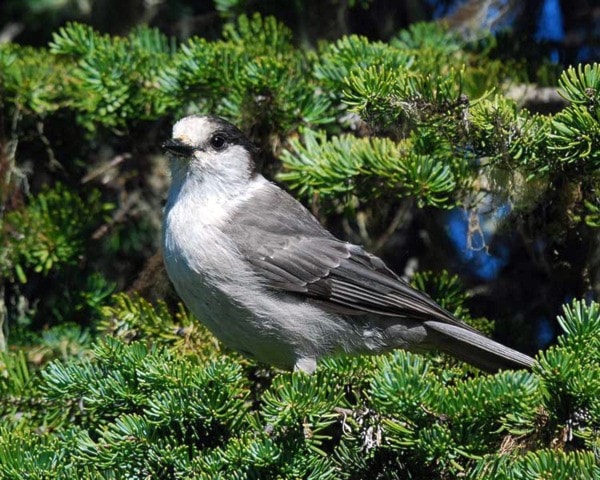Shortened days and cool nights remind us that fall is just around the corner.
This is a very important time for wildlife, as some prepare to migrate to their winter feeding grounds, or in the case of year-round residents, it is a time to harvest and store their winter supplies.
A recent visit to Mount Washington reacquainted me with a unique bird that is busily preparing for the harsh winter ahead; it also reminded me how we often innocently interfere with this process.
Fearless, adventuresome and inquisitive, the gray jay or “whiskey jack” is well known to hikers, skiers and visitors to the mountain. These birds are also known to provide companionship to hunters or homesteaders in remote areas where they become trusting and friendly.
Gray jays are part of the Corvid family, which includes crows, ravens and stellar jays, and they are known to be highly intelligent.
Found predominately in Canadian coniferous forests, they live at higher elevations, preferring pine, balsam and fir trees. Similar in size to a robin, they are designed to manoeuvre through the forest with great agility. Their short, rounded wings and long tails allow them to abruptly change direction and their strong legs and feet provide clinging power, enabling them to hang upside down on tree trunks.
As their name suggests, they are a combination of gray shades from light bodies, dark heads and pearl gray throats, cheeks and breasts. Black beaks are surrounded by gray whiskers and their lustrous brown eyes are highlighted in dark gray. Unlike stellar jays, they lack crested head feathers.
Gray jays have exceptionally dense, downy feathers to insulate them against the extreme winter temperatures and snowy conditions. Appearing silently out of the forest, they hop from branch to branch and suddenly start chattering noisily, announcing their presence.
On Mount Washington these birds have now become habituated to humans and can be very aggressive towards them, dive bombing those who are trying to enjoy their lunch.
Natural food for these birds includes insects, caterpillars, beetles and grubs, berries and nuts; they are also known to scavenge carrion from hunters after a successful hunt. Their diet does not include sandwiches, cookies or French fries, which can cause nutritional problems leading to starvation.
If you wish to feed these birds, take along some nuts or fruit or better still allow them to forage for themselves, especially in the fall.
Food storage for these jays is quite unique; they select the morsel and cover it in saliva — often they have more than one piece in their mouths. They then find a nook or cranny in a tree or rock crevice in which to hide the food, or will even stick the food to pine needles.
If you do decide to feed these birds, you should always wash or sanitize your hands. These birds especially are known to be carriers of diseases that can be transmitted to humans.
Feeding other creatures can also be detrimental to their health, and each year, MARS rescues creatures that are starving or have digestive problems caused by ingesting the wrong kind of food or being fed when they are too weak to digest the food.
Please do not feed ducks and swans bread, which is full of empty calories and bloats the bird, making it think it is full. Migratory birds stop over in our area and they need to feed on their natural diet, whether it be fish, grasses, or aquatic vegetation to complete a successful migration.
Many people feed other species of wildlife, and, again, there are pros and cons.
Birds and animals can become reliant on you if you feed them and become aggressive if you stop. An example are raccoons, which can become very aggressive and destructive.
Young eagles in their first winter can become reliant on an unnatural food supply, and when it is no longer available, together with inadequate hunting skills, they fall victim to starvation.
If you live on known deer crossings close to roads, encouraging deer to feed in your garden can result in them being hit by cars. Deer can also become a nuisance at bird feeders, as can bears.
If you choose to keep bird feeders through the winter, please be sure to clean them and the ground around them regularly. This prevents diseases spreading to other birds. Pine siskins are particularly prone to salmonella.
Also remember that bird feeders can also attract unwanted visitors like rats or mice and sometimes even small hawks that are just there to eat what is their natural prey, which just happens to be small songbirds!
Please remember as daylight saving time arrives, be extra cautious on the roads. It takes wildlife a while to adjust to the change, and they are foraging at the same time as most folk are commuting to and from work or school.
Please call 1-800-304-9968 to report injured wildlife. For further information, visit www.wingtips.org.
Sandy Fairfield is the educational co-ordinator for the Mountainaire Avian Rescue Society (MARS). The MARS column appears every second Friday.
